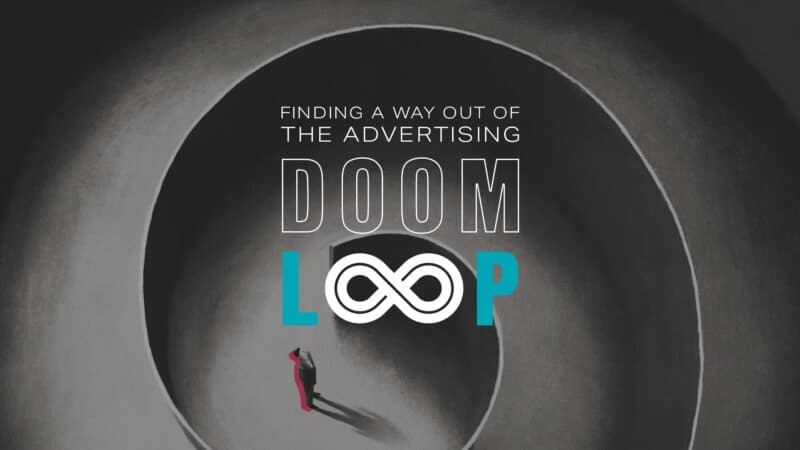
Marketing’s obsession with short-term wins has created a dangerous cycle. Brands keep investing in what’s immediately measurable while neglecting long-term growth — a trap WARC calls the “doom loop.” The result? Shrinking brand equity and unsustainable returns. To escape, we don’t just need a better media mix — we need more innovative marketing measurement.
Trapped in the doom loop: Short-term thinking is holding brands back
The recently published WARC “Multiplier Effect” study (registration required) sheds light on an all-too-familiar challenge. Our over-reliance on short-term performance marketing has led us into the doom loop — a cycle in which brands keep investing in what’s immediately measurable while starving brand-building marketing activity. The result? Shrinking brand equity, diminishing returns and unsustainable growth.
Marketers are caught in a trap — optimizing for clicks, conversions and return on ad spend (ROAS) in the near term while undermining long-term brand health. Here’s the twist: this isn’t just a media mix problem. It’s a measurement problem.
To escape the doom loop, we don’t need to swing the mix wildly back to brand — or abandon performance tactics altogether. We need to fix how we measure. After all, measurement isn’t just about proving value after the fact. It’s how we go to market with better strategies to begin with.
The pendulum swings back: Full-funnel rebalance
Unsurprisingly, performance marketing quickly became the CMO’s favorite child. With its promise of trackable results and immediate impact, performance media thrived in the digital transformation era. For over a decade, brands have doubled down on lower-funnel tactics to drive efficiency and meet aggressive growth targets.
Meta, Google and Amazon accounted for most US digital ad spending during this era. In addition to their massive reach, advances in algorithm-driven media have supported these dominant players.
But the pendulum is swinging. Many marketers realize that short-term gains have come at the expense of long-term brand building. As noted in a previous MarTech article, advertisers are rediscovering the power of upper-funnel investment — and learning how to build a business case for brand media using modern measurement methods.
Still, rebalancing the funnel isn’t easy. Performance budgets are so dominant that any shift upward raises eyebrows in the C-suite. Marketers are asked to justify brand spend with the same speed and precision as last-click attribution. That’s where more innovative measurement becomes the bridge between brand and performance — and the key to moving forward.
Why measurement is the missing link
The “doom loop” isn’t only fueled by media mix decisions — it’s driven by how we define success. When brand and performance teams operate in silos, with separate KPIs, goals and even creative approaches, they often end up competing for resources. Disparate, disconnected measurement reinforces that divide. We’ve created false trade-offs, where brand investment is seen as a “nice-to-have” because it doesn’t show up in the same dashboards as conversion campaigns. When we do this, we sacrifice long-term value for perceived short-term efficiency.
Measurement is the connective tissue that unites the full-funnel strategy. It doesn’t just prove value — it creates it by shaping how we plan, test and optimize across the entire customer journey.
Let’s also be honest: as marketers, many of us have also looped in our CFOs along the way. Finance teams have also become addicted to faulty attribution. Last-click logic and platform-reported ROAS are comfortable but misleading. They reward what’s easy to measure, not necessarily what drives real growth. To break the cycle, we need to change the conversation.
Dig deeper: The smarter approach to marketing measurement
Building an accountable full-funnel strategy
Full-funnel marketing investment should still be held accountable for business outcomes. All marketing must drive performance. That means eliminating internal silos, investing in more holistic measurement, and making data actionable in real-time.
Eliminate silos between brand and performance
Proper integration starts with people and processes. That means aligning creative, media and analytics teams around shared KPIs — not just clicks and conversions but also incremental growth across the funnel, new customer acquisition, brand love and loyalty.
Instead of separating brand and performance into different teams or budgets, leading marketing teams are structured around the customer journey. Cross-functional pods, centralized goals and unified reporting frameworks create a more agile, growth-focused culture.
Invest in holistic measurement
Breaking the doom loop requires more than just combining dashboards. It takes a diversified, thoughtful approach to measurement.
- Media mix modeling (MMM) is essential for capturing the impact of brand media. Modern MMMs can ingest granular first-party data, connect to outcomes like new customer acquisition and quantify the “base-building” effects of brand over time.
- Incrementality testing — such as geo-matched markets or audience holdouts — offers powerful proof of impact. These methods can isolate brand campaign effects on traffic, conversions and downstream performance efficiency.
- Brand lift studies remain a core tool for capturing shifts in awareness, consideration and intent. When layered with behavioral signals like share of search, site traffic and social engagement, these insights create a 360-degree view of brand performance.
Dig deeper: How to measure the impact of brand marketing
Make data actionable — and speed it up
One of marketers’ most significant mistakes is treating analytics and measurement as a hindsight function – generating after-the-fact report cards on campaign or seasonal marketing performance. Instead, treat it as a driver of strategy. Prior learnings and insights fuel strategic iteration for the next campaign, product launch or promotion.
Real-time data analysis, now super-charged by AI-enabled data platforms, lets marketers see how upper-funnel campaigns influence mid- and lower-funnel behavior. For example, a brand video might boost awareness and improve branded search efficiency, email open rates or store traffic.
When measurement is embedded in strategy and campaign design, it becomes a tool for agility and optimization. We can learn, adjust and scale what’s working — without waiting for quarterly reports.
From doom loop to real growth: What great looks like
What happens when brands get this right? My agency has seen brands increase upper-funnel investment while still growing revenue. In one case, a retailer launched an upper-funnel campaign targeted at net-new audiences and used MMM and holdout testing to isolate incremental traffic and conversions. The results justified the brand spend and revealed that new customer acquisition cost was lower than many performance channels.
In another example, a global brand used brand lift and share of search to validate awareness gains from a CTV campaign. Weeks later, they saw improved performance in retargeting and paid search — proving the halo effect of brand investment.
And perhaps most powerfully, we’ve helped marketers walk into budget meetings with CFOs armed with actual measurement — moving the conversation from “What’s the ROAS?” to “What’s the incremental value and how does it drive customer lifetime value?”
The road out of the doom loop
The answer to the doom loop isn’t to swing wildly in a new direction. It’s to evolve how we think about performance, which means:
- Expanding our definition of performance to include brand outcomes.
- Designing measurement systems that reflect how people make decisions — not just what they click.
Marketing today demands accountability and ambition. And the future belongs to marketers who can prove value at every stage of the journey. Don’t pick a side the next time you hear someone ask whether brand or performance deserves the budget. Instead, ask a better question:
- How do we measure what matters?
The post How smarter measurement can fix marketing’s performance trap appeared first on MarTech.
